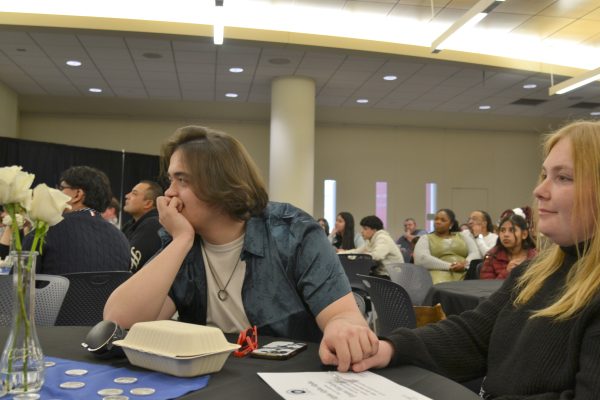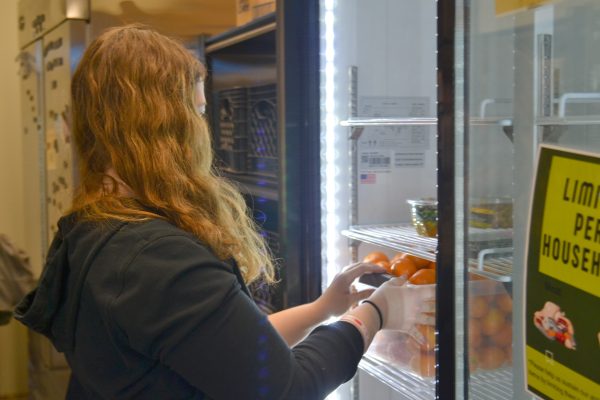Get plugged into Hamline’s new libraries
Provost’s initiative brings innovative technology to improve collaboration on campus.
Bush Library houses one of the campus’s first collaboration nodes. There is also one in the Law Library.
May 12, 2014
The Hamline libraries are taking a step into the new age. Provost Eric Jensen, Library Director Amy Sheehan and the initiative’s moderators are rethinking the roles the libraries have in teaching and learning. This initiative, one of five of the Provost’s initiatives, was launched last Thursday.
The library initiative has focused efforts on four major areas: physical spaces, technology and tools, services and collections. The four areas would help in repurposing space with the idea of teaching and learning in mind, and incorporating technology in order to foster and support student and faculty collaboration. It would provide direct access to research experts, taking into account student and faculty feedback.
Jensen explained these terms: “High impact learning has a lot of student to student interaction; it has a lot of student to faculty interaction. It’s geared towards not sitting in a room while one person speaks, but to somehow compliment what each other is doing- and the libraries can be hubs for that,” he said.
The proposal goes on to state that, “The piloting of active learning spaces in the libraries addresses three of those four areas we identified.” The initiative would redefine the library’s goals, according to Jensen. “It’s talking about how to recentralize the library as part of the academic experience.”
To initiate the proposal, a collaboration node has been set up in the Bush Library. A node has a large table with a TV on the end; the tables have connections for laptops and tablets so that students and staff can work together easily. There are plans to set up a second node in Bush, along with one in the Law Library.
However, the collaboration nodes aren’t the only thing the initiative calls for. “We hope to have all the active learning pilot spaces in both libraries up and running by early summer,” Sheehan said. “The initiative group will also continue to meet and work on developing plans for other changes.”
Collaboration nodes were developed through the use of white boards around campus, the library homepage and Google Drive, which were set up to gather feedback.The initiative could redefine the library’s goals, according to Provost Jensen. “It’s talking about how to recentralize the library as part of the academic experience.”
The initiative’s collaboration nodes were inspired not only by feedback provided by students and faculty, but the team also drew from other 21st Century libraries already in place to see what would work best at Hamline. Sheehan along with Associate Provost Mike Reynolds, and Lowell Bromander the Associate Vice President for Facilities Services, all toured a campus to do some on field research recently. “We were interested in seeing how other universities have enhanced student learning by capitalizing on these proximities between campus units,” Sheehan said. “Their facility opened in 2013 and it provided a nice example of some of the latest thoughts on physical spaces in libraries and how that relates to other campus services.”
If these collaboration nodes are a success, they may spread across campus. Sheehan mentioned that, “Since we are running these installations in our libraries as pilots, any data we learn from their use will help the university decide which other locations on campus might benefit from the same or a similar concept.”
The initiative is awaiting feedback from students and faculty; feedback can be presented to the ITS help desk in the basement of Bush Library. Sheehan said that to narrow down the feedback, the moderators, Provost Jensen, and herself, looked at articles from the library literature which focused on common issues regarding 21st Century libraries, as well as their knowledge of Hamline’s requirements.
The physical space of the collaboration nodes were designed with a testing purpose. Since there are no walls with each node, one of the evaluations of the initiative will be noise: how much is too much for those who want more of a closed workspace? Sheehan suggests that for the time being, those students should utilize either the Digital Media Arts lab located in Bush during evenings or weekends, or the Law library’s collaboration node as an alternative.
Currently, there are $75,000 set aside for the 21st Century Library initiative, but as far as long-term problems are concerned, according to Sheehan, the university’s budgeting process has space for changes in technology and facilities to an innovative proposal.
Since the initiative is in its testing stages, the feedback provided will be used to determine whether or not to keep the nodes, as well as what to improve on. Jensen stated that if they are serious about studying the results, they will accept the good or the bad. He said that students know best what works well and what doesn’t.
Sheehan spoke of flexibility and adapting if the results called for it. Currently, the Law library will be the only space with a reservation system, although Bush Library is open to the idea of doing this as well.
If these collaboration nodes are successful, they may spread across campus. “Since we are running these installations in our libraries as pilots, any data we learn from their use will help the university decide which other locations on campus might benefit from the same or a similar concept,” Sheehan said.
Provost Jensen spoke about the goals of the proposal. “I wanted us to get a chance as a community to think about where we want to be in five years or ten years in ways that are consistent with the strategic plan. Most strategic plans don’t have a lot of specific detail deliberately. So this is an attempt to sort of —you know—put a little flesh on the bones.”
Feedback is the key for this initiative. It calls on active student and faculty participation to find out what works best for the future of Hamline. Sheehan spoke of students currently needing to rearrange furniture or working in less than optimal situations to get group work completed. “We are open to hearing thoughts on other space needs. During these pilot implementations students using the spaces will have opportunities to share their thoughts on the collaboration spaces,” she said. “Student participation and input will also be used as we develop our overarching space plan for the libraries.”
To learn more about the library proposal, search “library initiative” on Hamline’s website.






